Jin Liu
University of Science and Technology of China
UniTac2Pose: A Unified Approach Learned in Simulation for Category-level Visuotactile In-hand Pose Estimation
Sep 19, 2025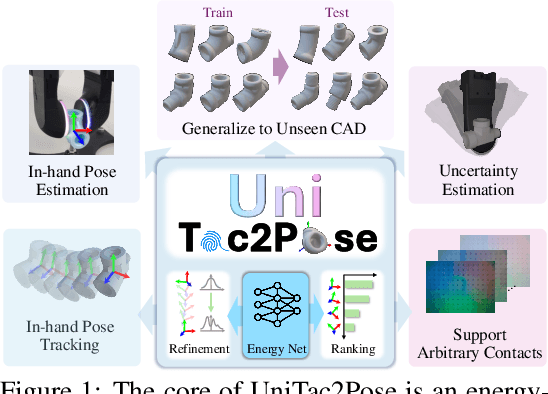
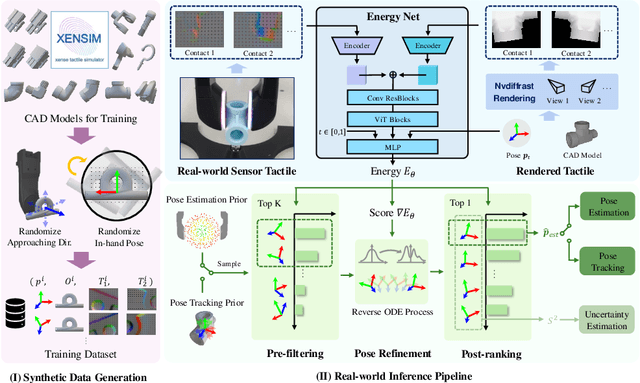

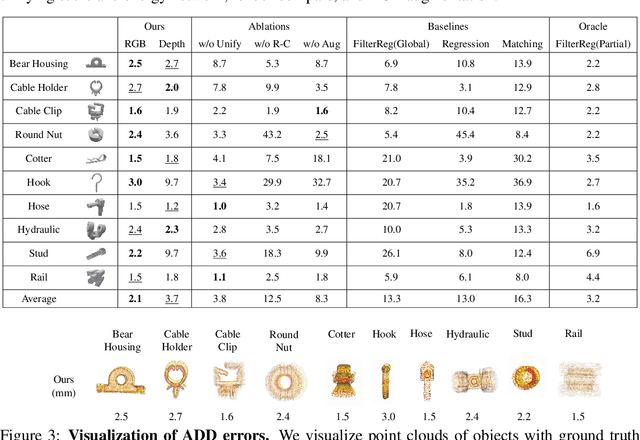
Abstract:Accurate estimation of the in-hand pose of an object based on its CAD model is crucial in both industrial applications and everyday tasks, ranging from positioning workpieces and assembling components to seamlessly inserting devices like USB connectors. While existing methods often rely on regression, feature matching, or registration techniques, achieving high precision and generalizability to unseen CAD models remains a significant challenge. In this paper, we propose a novel three-stage framework for in-hand pose estimation. The first stage involves sampling and pre-ranking pose candidates, followed by iterative refinement of these candidates in the second stage. In the final stage, post-ranking is applied to identify the most likely pose candidates. These stages are governed by a unified energy-based diffusion model, which is trained solely on simulated data. This energy model simultaneously generates gradients to refine pose estimates and produces an energy scalar that quantifies the quality of the pose estimates. Additionally, borrowing the idea from the computer vision domain, we incorporate a render-compare architecture within the energy-based score network to significantly enhance sim-to-real performance, as demonstrated by our ablation studies. We conduct comprehensive experiments to show that our method outperforms conventional baselines based on regression, matching, and registration techniques, while also exhibiting strong intra-category generalization to previously unseen CAD models. Moreover, our approach integrates tactile object pose estimation, pose tracking, and uncertainty estimation into a unified framework, enabling robust performance across a variety of real-world conditions.
Highly Undersampled MRI Reconstruction via a Single Posterior Sampling of Diffusion Models
May 13, 2025Abstract:Incoherent k-space under-sampling and deep learning-based reconstruction methods have shown great success in accelerating MRI. However, the performance of most previous methods will degrade dramatically under high acceleration factors, e.g., 8$\times$ or higher. Recently, denoising diffusion models (DM) have demonstrated promising results in solving this issue; however, one major drawback of the DM methods is the long inference time due to a dramatic number of iterative reverse posterior sampling steps. In this work, a Single Step Diffusion Model-based reconstruction framework, namely SSDM-MRI, is proposed for restoring MRI images from highly undersampled k-space. The proposed method achieves one-step reconstruction by first training a conditional DM and then iteratively distilling this model. Comprehensive experiments were conducted on both publicly available fastMRI images and an in-house multi-echo GRE (QSM) subject. Overall, the results showed that SSDM-MRI outperformed other methods in terms of numerical metrics (PSNR and SSIM), qualitative error maps, image fine details, and latent susceptibility information hidden in MRI phase images. In addition, the reconstruction time for a 320*320 brain slice of SSDM-MRI is only 0.45 second, which is only comparable to that of a simple U-net, making it a highly effective solution for MRI reconstruction tasks.
Streamlining Biomedical Research with Specialized LLMs
Apr 15, 2025Abstract:In this paper, we propose a novel system that integrates state-of-the-art, domain-specific large language models with advanced information retrieval techniques to deliver comprehensive and context-aware responses. Our approach facilitates seamless interaction among diverse components, enabling cross-validation of outputs to produce accurate, high-quality responses enriched with relevant data, images, tables, and other modalities. We demonstrate the system's capability to enhance response precision by leveraging a robust question-answering model, significantly improving the quality of dialogue generation. The system provides an accessible platform for real-time, high-fidelity interactions, allowing users to benefit from efficient human-computer interaction, precise retrieval, and simultaneous access to a wide range of literature and data. This dramatically improves the research efficiency of professionals in the biomedical and pharmaceutical domains and facilitates faster, more informed decision-making throughout the R\&D process. Furthermore, the system proposed in this paper is available at https://synapse-chat.patsnap.com.
Embodied Perception for Test-time Grasping Detection Adaptation with Knowledge Infusion
Apr 07, 2025



Abstract:It has always been expected that a robot can be easily deployed to unknown scenarios, accomplishing robotic grasping tasks without human intervention. Nevertheless, existing grasp detection approaches are typically off-body techniques and are realized by training various deep neural networks with extensive annotated data support. {In this paper, we propose an embodied test-time adaptation framework for grasp detection that exploits the robot's exploratory capabilities.} The framework aims to improve the generalization performance of grasping skills for robots in an unforeseen environment. Specifically, we introduce embodied assessment criteria based on the robot's manipulation capability to evaluate the quality of the grasp detection and maintain suitable samples. This process empowers the robots to actively explore the environment and continuously learn grasping skills, eliminating human intervention. Besides, to improve the efficiency of robot exploration, we construct a flexible knowledge base to provide context of initial optimal viewpoints. Conditioned on the maintained samples, the grasp detection networks can be adapted in the test-time scene. When the robot confronts new objects, it will undergo the same adaptation procedure mentioned above to realize continuous learning. Extensive experiments conducted on a real-world robot demonstrate the effectiveness and generalization of our proposed framework.
WHERE-Bot: a Wheel-less Helical-ring Everting Robot Capable of Omnidirectional Locomotion
Mar 10, 2025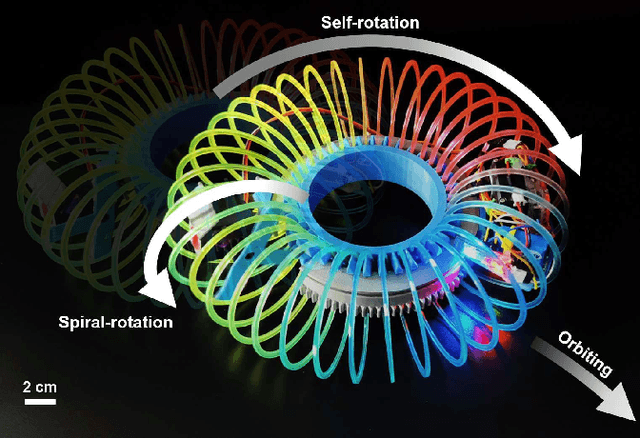
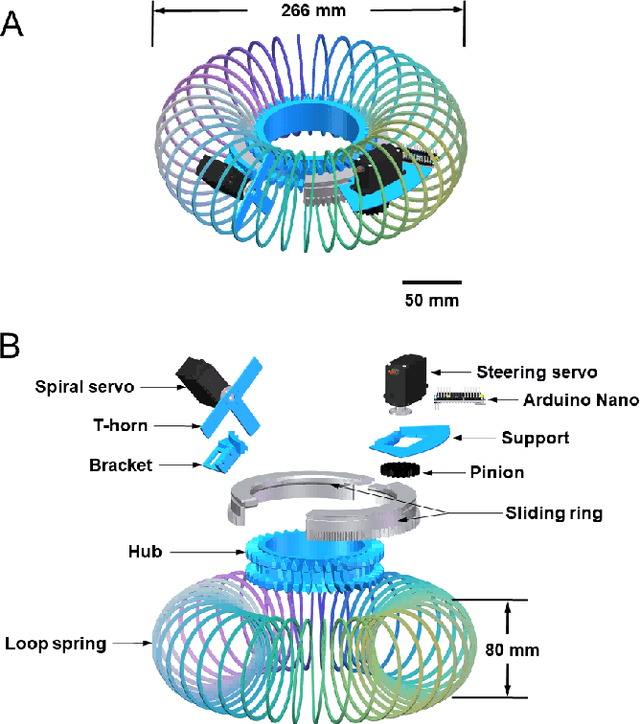
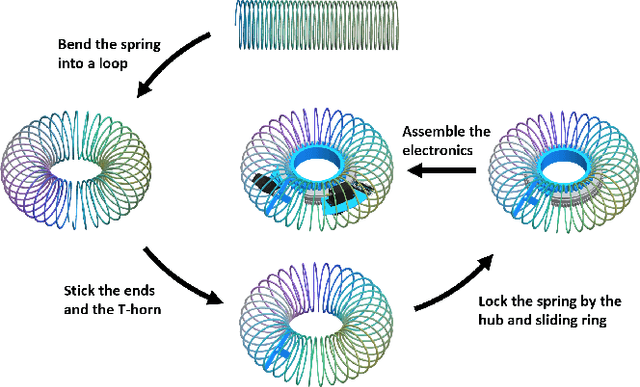
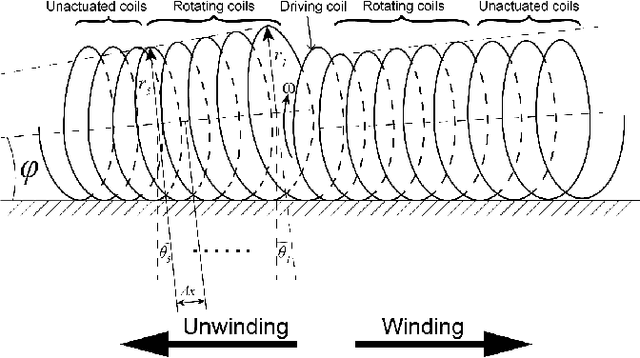
Abstract:Compared to conventional wheeled transportation systems designed for flat surfaces, soft robots exhibit exceptional adaptability to various terrains, enabling stable movement in complex environments. However, due to the risk of collision with obstacles and barriers, most soft robots rely on sensors for navigation in unstructured environments with uncertain boundaries. In this work, we present the WHERE-Bot, a wheel-less everting soft robot capable of omnidirectional locomotion. Our WHERE-Bot can navigate through unstructured environments by leveraging its structural and motion advantages rather than relying on sensors for boundary detection. By configuring a spring toy ``Slinky'' into a loop shape, the WHERE-Bot performs multiple rotational motions: spiral-rotating along the hub circumference, self-rotating around the hub's center, and orbiting around a certain point. The robot's trajectories can be reprogrammed by actively altering its mass distribution. The WHERE-Bot shows significant potential for boundary exploration in unstructured environments.
Quantifying patterns of punctuation in modern Chinese prose
Mar 06, 2025Abstract:Recent research shows that punctuation patterns in texts exhibit universal features across languages. Analysis of Western classical literature reveals that the distribution of spaces between punctuation marks aligns with a discrete Weibull distribution, typically used in survival analysis. By extending this analysis to Chinese literature represented here by three notable contemporary works, it is shown that Zipf's law applies to Chinese texts similarly to Western texts, where punctuation patterns also improve adherence to the law. Additionally, the distance distribution between punctuation marks in Chinese texts follows the Weibull model, though larger spacing is less frequent than in English translations. Sentence-ending punctuation, representing sentence length, diverges more from this pattern, reflecting greater flexibility in sentence length. This variability supports the formation of complex, multifractal sentence structures, particularly evident in Gao Xingjian's "Soul Mountain". These findings demonstrate that both Chinese and Western texts share universal punctuation and word distribution patterns, underscoring their broad applicability across languages.
ASurvey: Spatiotemporal Consistency in Video Generation
Feb 25, 2025Abstract:Video generation, by leveraging a dynamic visual generation method, pushes the boundaries of Artificial Intelligence Generated Content (AIGC). Video generation presents unique challenges beyond static image generation, requiring both high-quality individual frames and temporal coherence to maintain consistency across the spatiotemporal sequence. Recent works have aimed at addressing the spatiotemporal consistency issue in video generation, while few literature review has been organized from this perspective. This gap hinders a deeper understanding of the underlying mechanisms for high-quality video generation. In this survey, we systematically review the recent advances in video generation, covering five key aspects: foundation models, information representations, generation schemes, post-processing techniques, and evaluation metrics. We particularly focus on their contributions to maintaining spatiotemporal consistency. Finally, we discuss the future directions and challenges in this field, hoping to inspire further efforts to advance the development of video generation.
Pre-train and Fine-tune: Recommenders as Large Models
Jan 24, 2025



Abstract:In reality, users have different interests in different periods, regions, scenes, etc. Such changes in interest are so drastic that they are difficult to be captured by recommenders. Existing multi-domain learning can alleviate this problem. However, the structure of the industrial recommendation system is complex, the amount of data is huge, and the training cost is extremely high, so it is difficult to modify the structure of the industrial recommender and re-train it. To fill this gap, we consider recommenders as large pre-trained models and fine-tune them. We first propose the theory of the information bottleneck for fine-tuning and present an explanation for the fine-tuning technique in recommenders. To tailor for recommendation, we design an information-aware adaptive kernel (IAK) technique to fine-tune the pre-trained recommender. Specifically, we define fine-tuning as two phases: knowledge compression and knowledge matching and let the training stage of IAK explicitly approximate these two phases. Our proposed approach designed from the essence of fine-tuning is well interpretable. Extensive online and offline experiments show the superiority of our proposed method. Besides, we also share unique and important lessons we learned when deploying the method in a large-scale online platform. We also present the potential issues of fine-tuning techniques in recommendation systems and the corresponding solutions. The recommender with IAK technique has been deployed on the homepage of a billion-scale online food platform for several months and has yielded considerable profits in our business.
BS-LDM: Effective Bone Suppression in High-Resolution Chest X-Ray Images with Conditional Latent Diffusion Models
Dec 24, 2024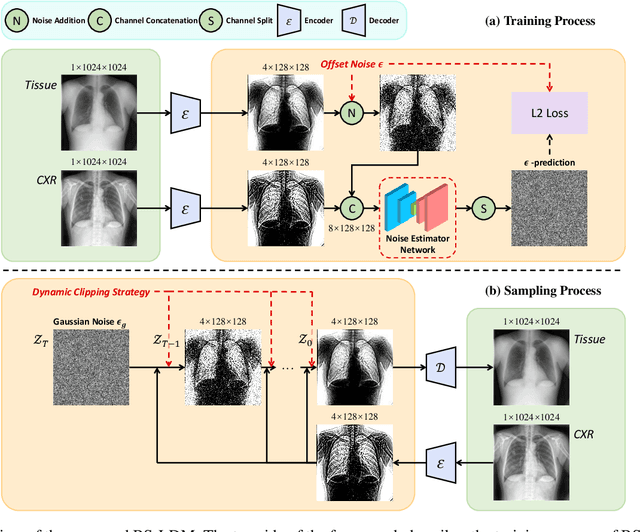

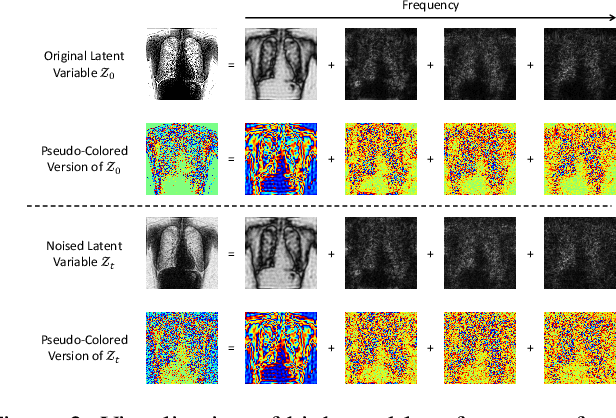

Abstract:The interference of overlapping bones and pulmonary structures can reduce the effectiveness of Chest X-ray (CXR) examinations. Bone suppression techniques have been developed to improve diagnostic accuracy. Dual-energy subtraction (DES) imaging, a common method for bone suppression, is costly and exposes patients to higher radiation levels. Deep learning-based image generation methods have been proposed as alternatives, however, they often fail to produce high-quality and high-resolution images, resulting in the loss of critical lesion information and texture details. To address these issues, in this paper, we introduce an end-to-end framework for bone suppression in high-resolution CXR images, termed BS-LDM. This framework employs a conditional latent diffusion model to generate high-resolution soft tissue images with fine detail and critical lung pathology by performing bone suppression in the latent space. We implement offset noise during the noise addition phase of the training process to better render low-frequency information in soft tissue images. Additionally, we introduce a dynamic clipping strategy during the sampling process to refine pixel intensity in the generated soft tissue images. We compiled a substantial and high-quality bone suppression dataset, SZCH-X-Rays, including high-resolution paired CXR and DES soft tissue images from 818 patients, collected from our partner hospitals. Moreover, we pre-processed 241 pairs of CXR and DES soft tissue images from the JSRT dataset, the largest publicly available dataset. Comprehensive experimental and clinical evaluations demonstrate that BS-LDM exhibits superior bone suppression capabilities, highlighting its significant clinical potential.
3D Gaussian Splatting for Large-scale 3D Surface Reconstruction from Aerial Images
Aug 31, 2024



Abstract:Recently, 3D Gaussian Splatting (3DGS) has garnered significant attention. However, the unstructured nature of 3DGS poses challenges for large-scale surface reconstruction from aerial images. To address this gap, we propose the first large-scale surface reconstruction method for multi-view stereo (MVS) aerial images based on 3DGS, named Aerial Gaussian Splatting (AGS). Initially, we introduce a data chunking method tailored for large-scale aerial imagery, making the modern 3DGS technology feasible for surface reconstruction over extensive scenes. Additionally, we integrate the Ray-Gaussian Intersection method to obtain normal and depth information, facilitating geometric constraints. Finally, we introduce a multi-view geometric consistency constraint to enhance global geometric consistency and improve reconstruction accuracy. Our experiments on multiple datasets demonstrate for the first time that the GS-based technique can match traditional aerial MVS methods on geometric accuracy, and beat state-of-the-art GS-based methods on geometry and rendering quality.
 Add to Chrome
Add to Chrome Add to Firefox
Add to Firefox Add to Edge
Add to Edge